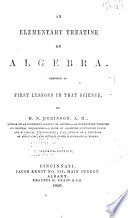 | Thomas Tate (mathematical master.) - 1847 - 138 σελίδες
...THEOREMS. 34. The following theorems ought to be committed to memory. (a+b) x (ai) = aO-62. That is, the product of the sum and difference of two quantities is equal to the difference of their squares. Thus we have, (2x + 3a) x (2x-3a) = 4x* — 9a2. And so on to other cases. 35. When a quantity is multiplied... | |
 | Charles William Hackley - 1847 - 546 σελίδες
...c=0, the proposed equation will become altogether indeterminate. The numerator, being the pro Tw : cf the sum and difference of two quantities, is equal to the difference of their aquaies. to wit: b1 — (4*-f-4ac)= — toe. We see, therefore, that Sa is a common factor to tbe.namjr:itor... | |
 | Horatio Nelson Robinson - 1848 - 354 σελίδες
...86. Prod. 4a2— 962. Multiply 3y — c by 3y — c. Prod. 9y2 — ca. Thus, by inspection, we find the product of the sum and difference of two quantities is equal to the difference of their squares. The propositions included in this article are proved also in geometry. (Art. 14.) We can sometimes... | |
 | Joseph Ray - 1848 - 250 σελίδες
...10a262+64. But 0+6 represents the sum of two quantities, and a — 6, their difference ; hence, THEOREM III. The product of the sum and difference of two quantities, is equal to the difference of their squares. EXAMPLES. 1. (5+3)(5—3)=25— 9=16=8X2. 2. (2a+6)(2a— 6)=4a2— b\ 3. (2x+32/)(2x-3y)=4x2-9/. 4.... | |
 | Jeremiah Day, James Bates Thomson - 1848 - 264 σελίδες
...yny3. 20. If a-\-b be multiplied into a — b, the product will be a2 — b2, (Art. 86 ;) that is, 191. The product of the. sum and difference of two quantities, is equal to the. difference of their squares. This is an instance of the facility with which general truths are demonstrated in algebra. If the sum... | |
 | Charles William Hackley - 1849 - 534 σελίδες
...c=0, the proposed equation will become altogether indeterminate. The numerator, being the pro-'luri of the sum and difference of two quantities, is equal to the difference of their squares, to wit : tt> — (i*-f-4ae)= — 4ac. We «ee, therefore, that Sa is a common factor to the numerator... | |
 | Harvey Goodwin - 1849 - 588 σελίδες
...easily seen by actual multiplication, that (a + b) x (a - 6) = a' - 6", or that the product of t?ie sum and difference of two quantities is equal to the difference of their squares ; a theorem which may be used in the multiplication of such quantities as those in the last example,... | |
 | Horatio Nelson Robinson - 1850 - 256 σελίδες
...power of a quantity, it always means the power of its numeral value considered abstractly. (ART. 17.) THE PRODUCT OF THE SUM AND DIFFERENCE OF TWO QUANTITIES IS EQUAL TO THE DIFFERENCE OF THEIR SQUARES, as will be seen by inspecting the following products : The first example should be multiplied in full... | |
 | William Smyth - 1851 - 272 σελίδες
...a be one of the quantities and b the other ; then (a + b) (a — b) = a? — b2. We thus learn that the product of the sum and difference of two quantities is equal to the difference of their squareS. These propositions are demonstrated, in geometry, in another form, where it is shown, 1°, That if... | |
 | Joseph Ray - 1848 - 250 σελίδες
...^ But a+6 represents the sum of two quantities, and a — b, their difference ; hence, THEOREM III. The product of the sum and difference of two quantities, is equal to the difference of their squares. EXAMPLES. 1. (5+3)(5-3)=25-9=16=8X2. 2. (2a+6)(2a— 6)=4a*— V. 3. (2z+3y)(2x-3y)=4z'-9i/2. 4. (5a+46)(5a—... | |
| |